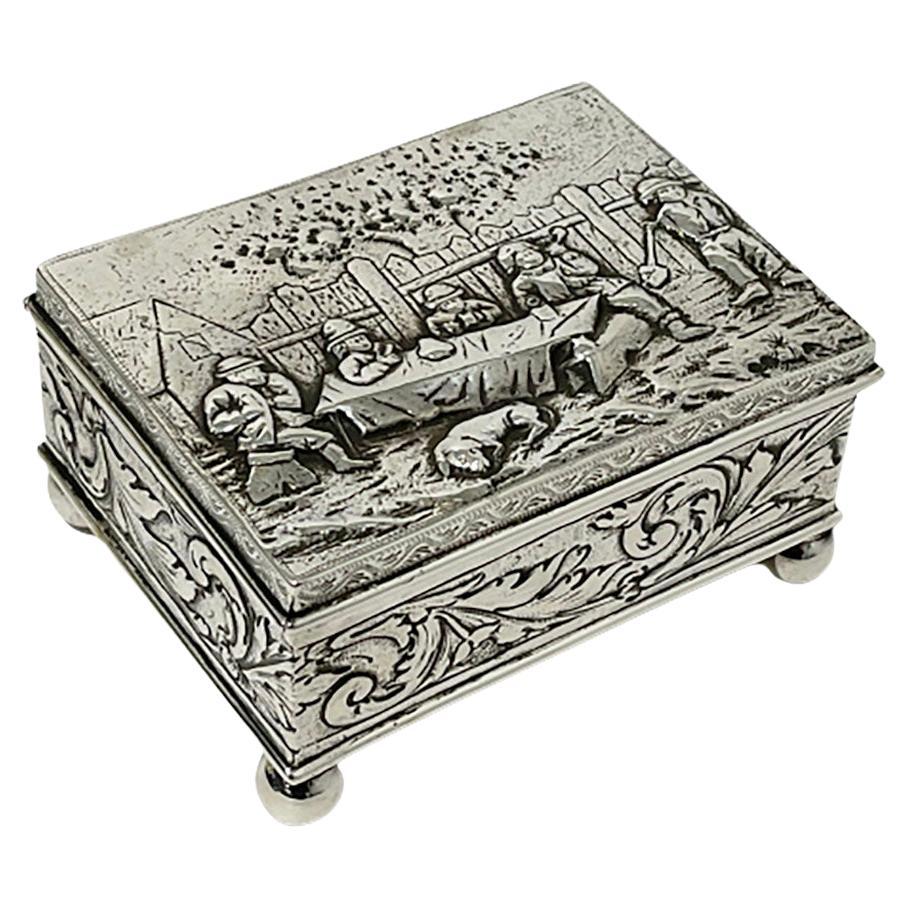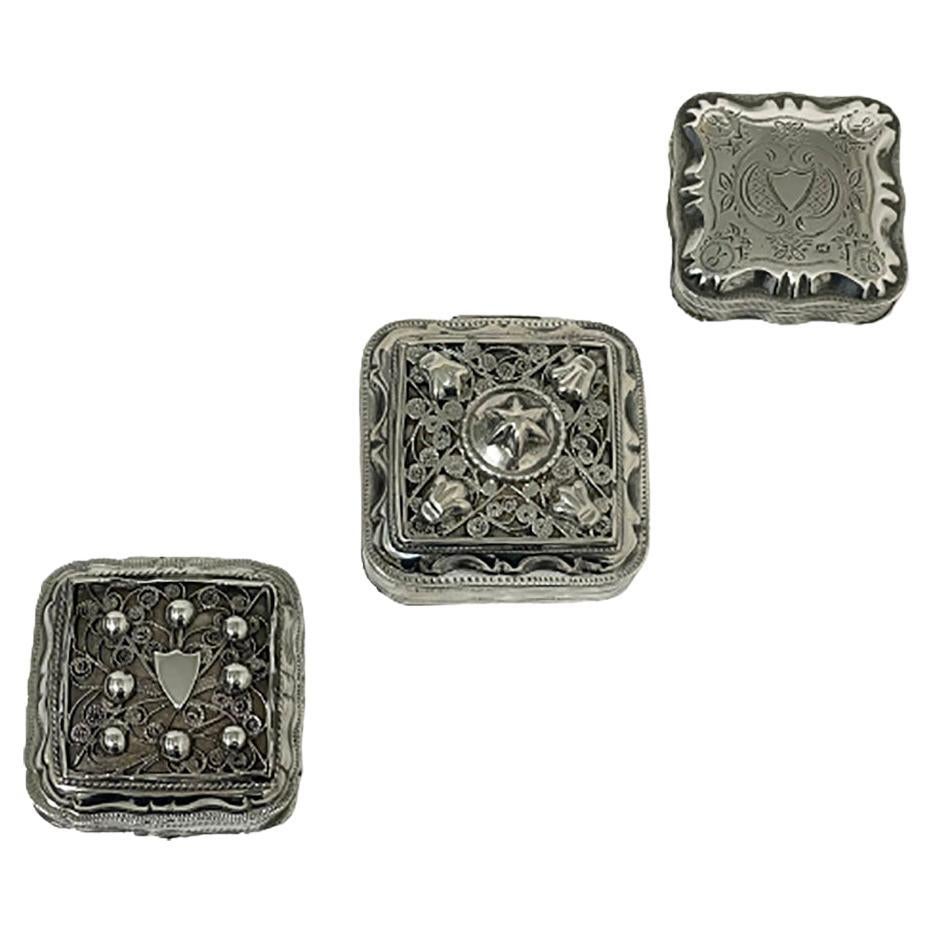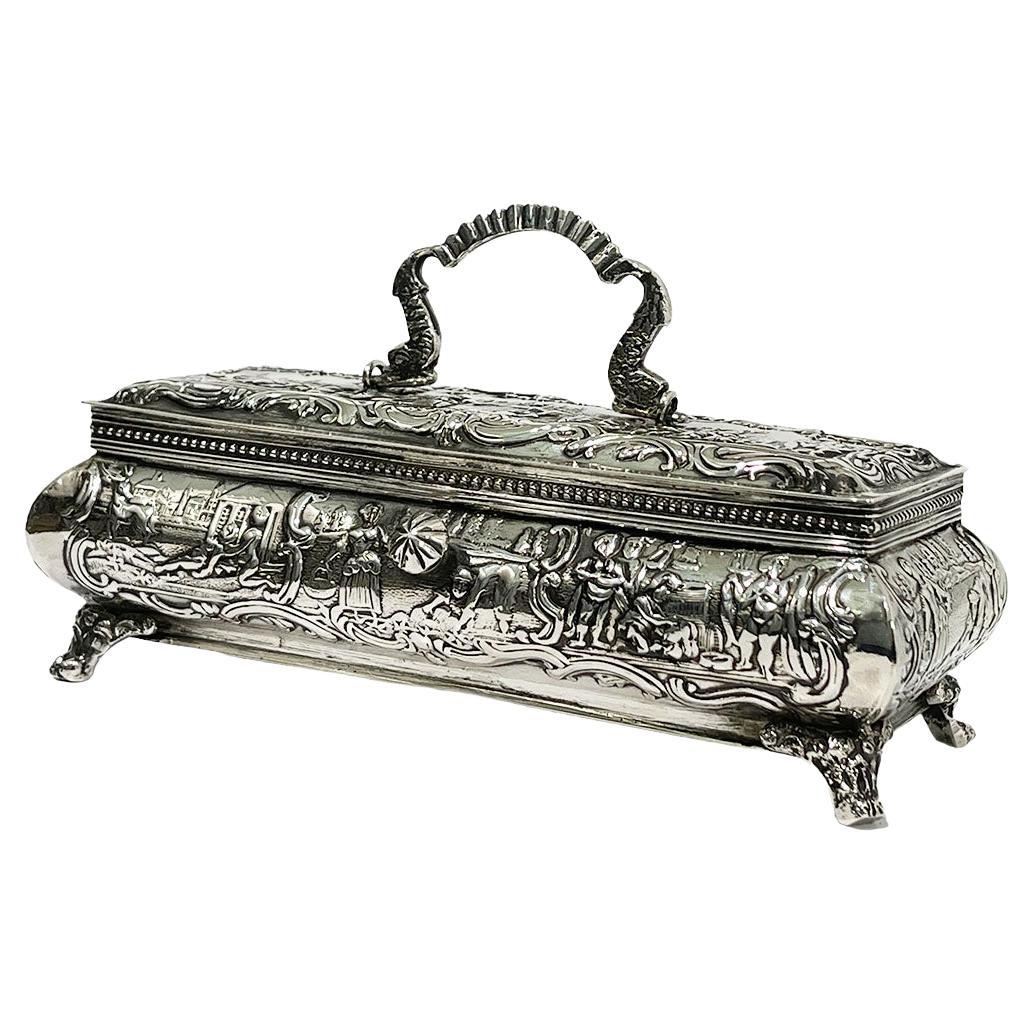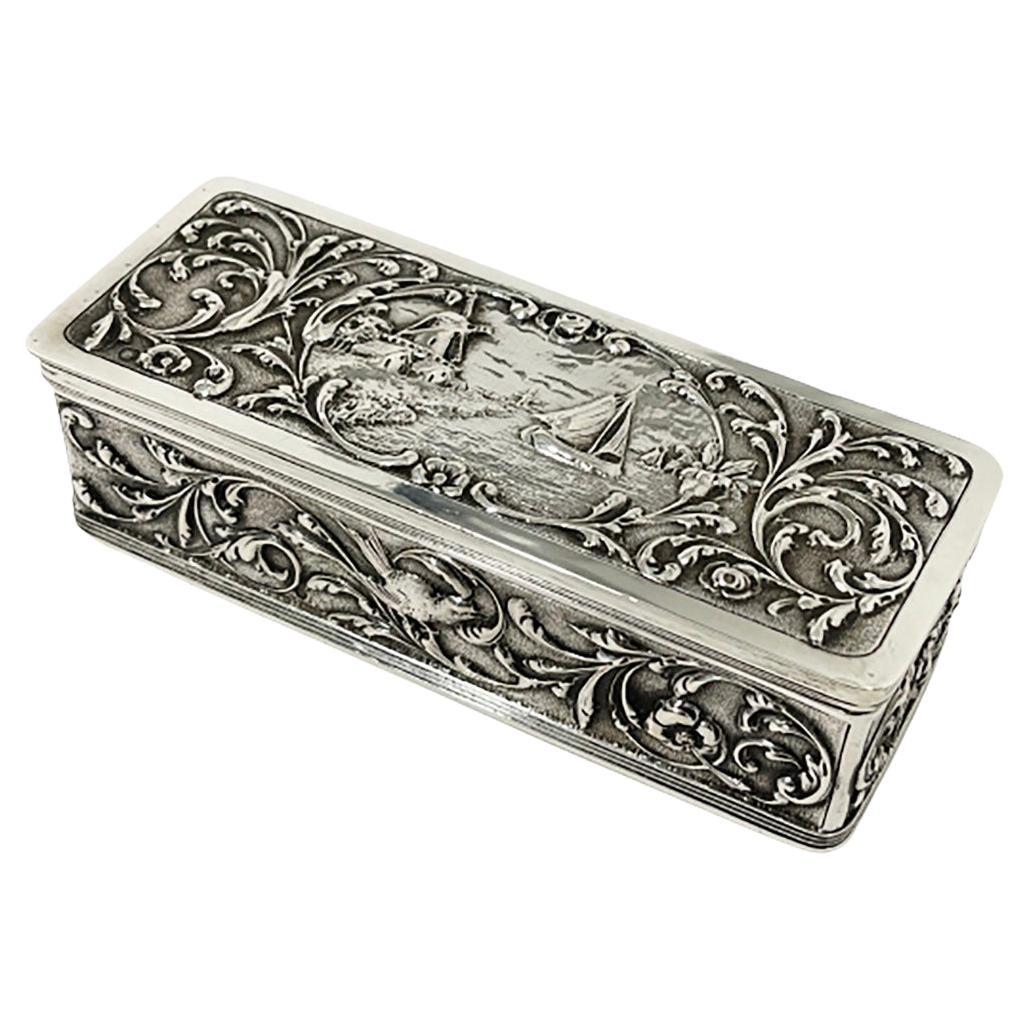Items Similar to Fine 17th Century Dutch Colonial Armorial Tortoiseshell & Silver Box, Dated 1691
Want more images or videos?
Request additional images or videos from the seller
1 of 3
Fine 17th Century Dutch Colonial Armorial Tortoiseshell & Silver Box, Dated 1691
About the Item
A dutch tortoiseshell box with two engraved silver plaques
Amsterdam, 1691, with maker's mark of Steven des Rousseaux (1654-1733)
H. 5 cm
Diam. 12.5 cm
Note:
Steven des Rousseaux (Paris circa 1654 - Amsterdam 1733) in 1672 worked for the silversmith and assayer Roelof Hensbergen in Amsterdam. In 1681 he was registered as citizen of Amsterdam and silversmith. Des Rousseaux must have been prominent in the silver guild because in 1695 he was chosen headman of the silver guild and in 1710 he became member of the “Goede Mannen” who mediate in disputes between silver smiths and their clients. His maker’s mark is only on the silver plaque on the underside of the box, with the coat of arms of Costantijn Ranst (1635- 1714), suggesting that Ranst ordered the silver from des Rousseaux and had it made as a present to a member of the family whose coat of arms is engraved in the silver of the lid. The engraved coat of arms on the silver lid was initially thought to belong to the van Etten family from the small town of Etten-Leur in Brabant (see Uit Verre Streken, October 2016). However in 1691 that family was already long extinct in the male line. After additional research the coat of arms with the three castles can now be safely attributed to the Bijsterus family. Henricus Bijsterus, a Remonstrant clergyman, in 1670 became citizen of Amsterdam. His wife Hester Gravia (1635-1685) was the widow of Johan Hop, the brother of the powerful Grand Pensionary of Amsterdam Cornelis Hop (1620-1704).
In 1670 or 1671 Henricus and Hester had a son, Wilhelmus Bijsterus who later would have very close relations with Cornelis Hop. Cornelis would even become godfather to Wilhelmus’ son. Hester’s sister Catharina (1655-1735) was married to Isaac Ruts (1635-1712), member of a very rich and influential Amsterdam merchant family. After Hester’s death Henricus remarried Elsje Colijn (1634-1706), again a member of an important Amsterdam patrician family. Henricus died in 1688 so a few years before the box was made.
His son Wilhelmus studied at the Remonstant Seminary in Amsterdam. In 1694 he became burgher of Amsterdam and in 1701 Remonstrant clergyman, subsequently in Warmond, Delft and Amersfoort. He died in Leiden in 1749. In 1691, when the box was made, Wilhelmus was barely 20 years of age. Eventhough Constantijn Ranst was one of the richest men of Amsterdam why should he give a young man such a precious present? In 1691 Wilhelmus became a member of the Remonstrant Brotherhood of which Ranst already was a member and as such a good acquaintance of his father, the former Remonstrant clergyman in Amsterdam. Constantijn and Wilhelmus moved in the same Amsterdam circles and were almost neighbours, Ranst living on the Herengracht and Wilhelmus with his stepmother on the Keizersgracht. Another possible candidate is Lucas Bijsterus, born in 1651 or 1652 in Alkmaar.
In 1674 Lucas married Lijsbeth van Velsen, daughter of the bookprinter Jacob Samuelsz van Velsen in Amsterdam and till at least 1682 worked as a bookprinter and editor in Amsterdam. In 1692 Lucas, as a widower, turned up in Rotterdam where he married Neeltje Jacobsdr van Raemburgh. They had a son Simon who was baptized in the Remonstrant church in 1693. If Lucas left Amsterdam in 1691, could Ranst have given the box as a farewell present? We don’t know but personally I think Wilhelmus is the more likely candidate to have received the box from Ranst. However, family relationships can be traced but friendship relationships are much more difficult to trace. Constantijn Ranst, born in Amsterdam in 1635, signed up with the VOC and sailed to Batavia in 1659, making a stop at the Cape of Good Hope where he met Jan van Riebeeck who founded the Dutch settlement at the Cape.
In 1662 Ranst was sent to Deshima where he became Secunde for a year. From 1665 till 1667 he was “Opperhoofd” in Tonkin and in 1668 he was back in Deshima as “Opperhoofd”. From 1669 till 1673 he was Director of Bengal in Hugli. After his return to Batavia he was elected in the “Raad van Indië”. In 1677 he sailed back to Holland as Admiral of the return-fleet. He settled in Amsterdam where he bought Herengracht 527 and neighbouring 529, two very important canal houses, and he also bought seven warehouses on the Prinsengracht. In 1664 in Batavia he had married Hester Hartsinck, daughter of Carel Hartsinck, Director of Indië. A daughter born in 1671, called Hester like her mother, back in Holland married Jacob Hinlopen, one of the directors of the West Indiën Company. In 1717 Herengracht 257 was rented out to Tsar Peter the Great during his second visit to Holland, who apparently left it in a mess. Jacob Hinlopen inherited the house and until recently it housed the Geelvinck Hinlopen Museum. During the Dutch Golden Age Constantijn Ranst was one of the 250 richest men of the country and he owned a painting by Rembrandt “the adoration of the three Magi”.
- Dimensions:Height: 1.97 in (5 cm)Diameter: 4.93 in (12.5 cm)
- Materials and Techniques:
- Place of Origin:
- Period:
- Date of Manufacture:1691
- Condition:Wear consistent with age and use.
- Seller Location:Amsterdam, NL
- Reference Number:1stDibs: LU5458220973362
About the Seller
5.0
Vetted Seller
These experienced sellers undergo a comprehensive evaluation by our team of in-house experts.
Established in 1985
1stDibs seller since 2020
19 sales on 1stDibs
Typical response time: 2 hours
- ShippingRetrieving quote...Ships From: Amsterdam, Netherlands
- Return PolicyA return for this item may be initiated within 7 days of delivery.
More From This SellerView All
- Splendid and Heavy Late 17th Century Dutch-Colonial Silver Filigree SalverLocated in Amsterdam, NLA splendid and heavy Dutch-colonial silver filigree salver Indonesia, Batavia (Jakarta) or possibly Padang, West Sumatra, 2nd half 17th century Diam. 22.9 cm Weight 551 grams This filigree-work was probably done by Chinese masters...Category
Antique 17th Century Indonesian Dutch Colonial Metalwork
MaterialsSilver
- Dutch Colonial Silver Dish with the Von Pfeffel Coat-of-arms, 17th CenturyLocated in Amsterdam, NLAn unusual Indonesian lobbed silver dish Jakarta (Batavia) or Coromandel coast, third quarter 17th century, apparently unmarked The eight lobbed dish exuberantly decorated with floral motifs, with the middle section replaced, consisting of indistinctly marked German silver from the early 19th century, bearing the coat-of-arms of the Von Pfeffel family. Diam. 30.5 cm Weight 461 grams Note: Lobbed silver dishes with exuberant floral decorations were characteristic of the decorative arts in the Netherlands in the first half of the 17th century. This style of floral decoration was adopted by silversmiths as well as by furniture makers working on the Coromandel Coast and in Batavia, often by workers who had fled the Coromandel Coast because of war and famine. In Batavia this style was known as “Custwerck” (work from the Bengal coast). These lobbed dishes are seldom marked. Only after 1667 the use of the town mark became obligatory in Batavia but only for silver made in Batavia not for silver imported in Batavia from other VOC settlements. The engraved coat of arms in the centre is a replacement of the original centre. The coat of arms can be identified as those of Christian Hubert von Pfeffel (1765- 1834). As a diplomat, statesman, ambassador of Bavaria in London and Saxony and councillor to the King of Bavaria, he was made “Freiherr” in 1828 and since then used this coat of arms. His son Karl Maximilian Friederich Hubert Freiherr von Pfeffel (1811-1890) in 1836 married Karoline Adelheid Pauline von Rottenburg (1805-1872), the natural daughter of Prins Paul von Württemberg (1785-1852) and his mistress Margrethe Porth. Paul was the jounger brother of the King Wilhelm I of Württemberg (1781-1864). The heraldic motto of the von Pfeffels Vur Schande habe den Huot means as much as “Beware of Shame”. Christian Hubert Theodoor Marie Karl von Pfeffel Karl Maximilian’s grandson was the last male in the von Pfeffel line. His daughter, Marie Louise (Paris in 1882 - Cornwall 1944), born and grown-up in France, changed her name in de Pfeffel. She was the great grandmother of Boris Alexander de Pfeffel Johnson, the present British Secretary of State. None of the members of the von Pfeffel family had any direct links with the Dutch East Indies but indirectly by way of the Royal House of Württemberg they did. Sophia Frederika Mathilda von Württemberg (1818-1877), daughter of Wilhelm I King of Württemberg, in 1839 married Willem III...Category
Antique Late 17th Century Indonesian Dutch Colonial Sterling Silver
MaterialsSilver
- 17th century colonial Sinhalese ebony two-door cabinet with silver mountsLocated in Amsterdam, NLA splendid Dutch-colonial Sinhalese ebony two-door cabinet with silver mounts Sri Lanka, Kandy, 2nd half 17th century, the mounts later The cabinet with a central drawer with hidde...Category
Antique 17th Century Sri Lankan Dutch Colonial Jewelry Boxes
MaterialsSilver
- Fine Japanese Namban Lacquer Jewelry Casket, 17th CenturyLocated in Amsterdam, NLJapanese Namban lacquer transition-style coffer with two drawers Kyoto/Nagasaki, circa 1650 The cartouches with gilt and red decorations of leaves...Category
Antique 17th Century Japanese Edo Lacquer
MaterialsCypress
- Rare 17th Century Silver Reliquary Arm MonstranceLocated in Amsterdam, NLA rare silver reliquary arm with relic bone, with the coat-of-arms of Cosme Roger (1671-1710), bishop of Lombez, France, with original bone relic Poss...Category
Antique Late 17th Century Italian Renaissance Religious Items
MaterialsSterling Silver
- Fine Dutch Colonial Indonesian Casket with Silver Mounts, circa 1706Located in Amsterdam, NLA fine Indonesian Ambonya burl, ebony and teak casket with silver mounts Jakarta (Batavia), circa 1706 (year letter W (1705-1710), marked DV, probably Dirck Vooght The outer ri...Category
Antique Early 18th Century Indonesian Dutch Colonial Decorative Boxes
MaterialsSterling Silver
You May Also Like
- Silver Box by Simon Rosenau with a Scene of 5 Men Drinking in the 17th CenturyBy Simon RosenauLocated in Delft, NLSilver Box by Simon Rosenau with a scene of 5 men drinking in the 17th Century Richly decorated silver box, interior covered with a yellow fabric, raised at 4 ball feet, decorated w...Category
Antique 19th Century German Sterling Silver
MaterialsSilver
- 3 Dutch Silver Peppermint BoxesLocated in Delft, NL3 Dutch silver peppermint boxes 2 boxes from the 19th century, around 1860-1870 and the 3rd box was made by J. Niekerk around 1998. All are 835/1000 purity of silver ( marked w...Category
Antique 19th Century Dutch Sterling Silver
MaterialsSilver
- 19th Century Dutch Silver Box by Willem van Baren, Schoonhoven, 1886Located in Delft, NL19th century Dutch silver box by Willem van Baren, Schoonhoven, 1886 A silver box with a hinged lid. The handle of the lid are 2 dolphins. The reli...Category
Antique 19th Century Dutch Sterling Silver
MaterialsSilver
- Dutch Mid 19th Century Wooden Spoon Box with 12 Silver Tea SpoonsLocated in Delft, NLA Dutch mid 19th century wooden spoon box with 12 silver tea spoons A mahogany wooden spoon box with red velvet fabric with 12 silver tea spoons. Dutch s...Category
Antique Mid-19th Century Sterling Silver
MaterialsSilver
- Dutch Silver box by Zaanse Zilversmederij, 1916Located in Delft, NLDutch Silver box by Zaanse Zilversmederij, 1916 A Dutch silver box 835/1000 purity of silver, completely Dutch silver hallmarked. With lion, master's...Category
Early 20th Century Dutch Sterling Silver
MaterialsSilver
- George Reevers, Dutch .934 Silver Biscuit Box, Rope Borders, Holland, C.1838Located in Chatham, ONGEORGE REEVERS (Maker - Silversmith) - Extraordinary and rare Dutch fine silver round biscuit box - 934/1000 silver - finest quality and timeless design (nearly 200 years old) - classic rope twist borders (two to the top and one to the base) - indent to the edge of the hinged lid for easy opening and grip - original green wool felt base liner (not photographed...Category
Antique 1830s Dutch Neoclassical Sterling Silver
MaterialsSterling Silver
Recently Viewed
View AllMore Ways To Browse
Silver Men
Sterling Men
Mens Sterling
Mens Sterling Silver
Silver Call Box
Colonial Dutch
Small Sterling Box
Colonial Furniture Dutch
Holland And Sons Furniture
Holland And Son
Holland And Sons
Dated 17th Century Furniture
Antique Colonial Kitchen
Dutch Safe
Dior Silver Box
Box Castle
Colonial Furniture Company
Jacob Amsterdam





